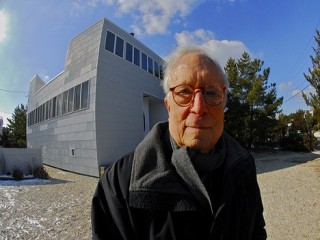
Robert Venturi biography
Date of birth : 1925-06-25
Date of death : -
Birthplace : Philadelphia, Pennsylvania, U.S.
Nationality : American
Category : Arhitecture and Engineering
Last modified : 2012-01-17
Credited as : architect, awarded the Pritzker Prize, founding principal of the firm Venturi, Scott Brown and Associates
1 votes so far
Venturi was awarded the Pritzker Prize in Architecture in 1991. He is also known for coining the maxim "Less is a bore" a postmodern antidote to Mies van der Rohe's famous modernist dictum "Less is more".
A controversial critic of the blithely functionalist and symbolically vacuous architecture of corporate modernism during the 1950s, Venturi has been considered a counterrevolutionary. He published his "gentle manifesto," Complexity and Contradiction in Architecture in 1966, described in the introduction by Vincent Scully to be "probably the most important writing on the making of architecture since Le Corbusier's 'Vers Une Architecture', of 1923." Derived from course lectures at the University of Pennsylvania, Venturi received a grant from the Graham Foundation in 1965 to aid in its completion. The book demonstrated, through countless examples, an approach to understanding architectural composition and complexity, and the resulting richness and interest. Drawing from both vernacular and high-style sources, Venturi introduced new lessons from the buildings of architects both familiar (Michelangelo, Alvar Aalto) and then forgotten (Frank Furness, Edwin Lutyens). He made a case for "the difficult whole" rather than the diagrammatic forms popular at the time, and included examples—both built and unrealized—of his own work to demonstrate the possible application of the techniques illustrated within. The book has been translated and published in 18 languages.
Immediately hailed as a theorist and designer with radical ideas, Venturi went to teach a series of studios at the Yale School of Architecture in the mid-1960s. The most famous of these was a studio in 1968 in which Venturi and Scott Brown, together with Steven Izenour, led a team of students to document and analyze the Las Vegas Strip, perhaps the least likely subject for a serious research project imaginable. In 1972, Venturi, Scott Brown and Izenour published the folio, A Significance for A&P Parking Lots, or Learning from Las Vegas later revised in 1977 as Learning from Las Vegas: the Forgotten Symbolism of Architectural Form using the student work as a foil for new theory. This second manifesto was an even more stinging rebuke to orthodox modernism and elite architectural tastes. The book coined the terms "Duck" and "Decorated Shed"--descriptions of the two predominant ways of embodying iconography in buildings. The work of Venturi, Rauch and Scott Brown adopted the latter strategy, producing formally simple "decorated sheds" with rich, complex and often shocking ornamental flourishes. Though he and his wife co-authored several additional books at the end of the century, these two have proved most influential.
The architecture of Robert Venturi, although perhaps not as familiar today as his books, helped redirect American architecture away from a widely practiced, often banal, modernism in the 1960s to a more exploratory, and ultimately eclectic, design approach that openly drew lessons from historic architecture and responded to the everyday context of the American city.Venturi's buildings typically juxtapose architectural systems, elements and aims, to acknowledge the conflicts often inherent in a project or site. This "inclusive" approach contrasted with the typical modernist effort to resolve and unify all factors in a complete and rigidly structured—and possibly less functional and simplistic—work of art. The diverse range of buildings of Venturi's early career offered surprising alternatives to then current architectural practice, with "impure" forms (such as the North Penn Visiting Nurses Headquarters), apparently casual asymmetries (as at the Vanna Venturi House), and pop-style supergraphics and geometries (for instance, the Lieb House).
Venturi created the firm Venturi and Short with William Short in 1960. After John Rauch replaced Short as partner in 1964, The firm's name changed to Venturi and Rauch. Venturi married Denise Scott Brown on July 23, 1967 in Santa Monica, California, and in 1969, Scott Brown joined the firm as partner in charge of planning. In 1980, The firm's name became Venturi, Rauch and Scott Brown, and after Rauch's resignation in 1989, Venturi, Scott Brown and Associates. The firm, based in Philadelphia, was awarded the Architecture Firm Award by the American Institute of Architects in 1985. Recent work has included many commissions from academic institutions, including campus planning and university buildings, and civic buildings in London, Toulouse and Japan.
Venturi's architecture has had world-wide influence, beginning in the 1960s with the dissemination of the broken-gable roof of the Vanna Venturi House and the segmentally arched window and interrupted string courses of Guild House. The playful variations on vernacular house types seen in the Trubeck and Wislocki Houses offered a new way to embrace, but transform, familiar forms. The facade patterning of the Oberlin Art Museum and the laboratory buildings demonstrated a treatment of the vertical surfaces of buildings that is both decorative and abstract, or both vernacular and modern. Venturi's work arguably provided a key influence at important times in the careers of architects Robert A. M. Stern, Philip Johnson, Michael Graves, Graham Gund and James Stirling, among others.
















